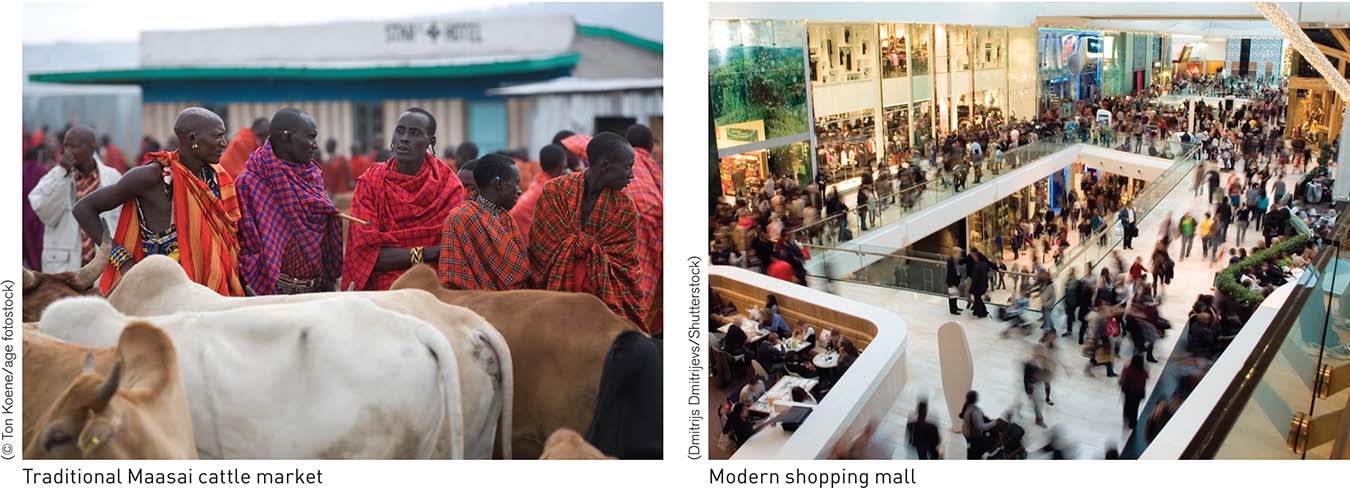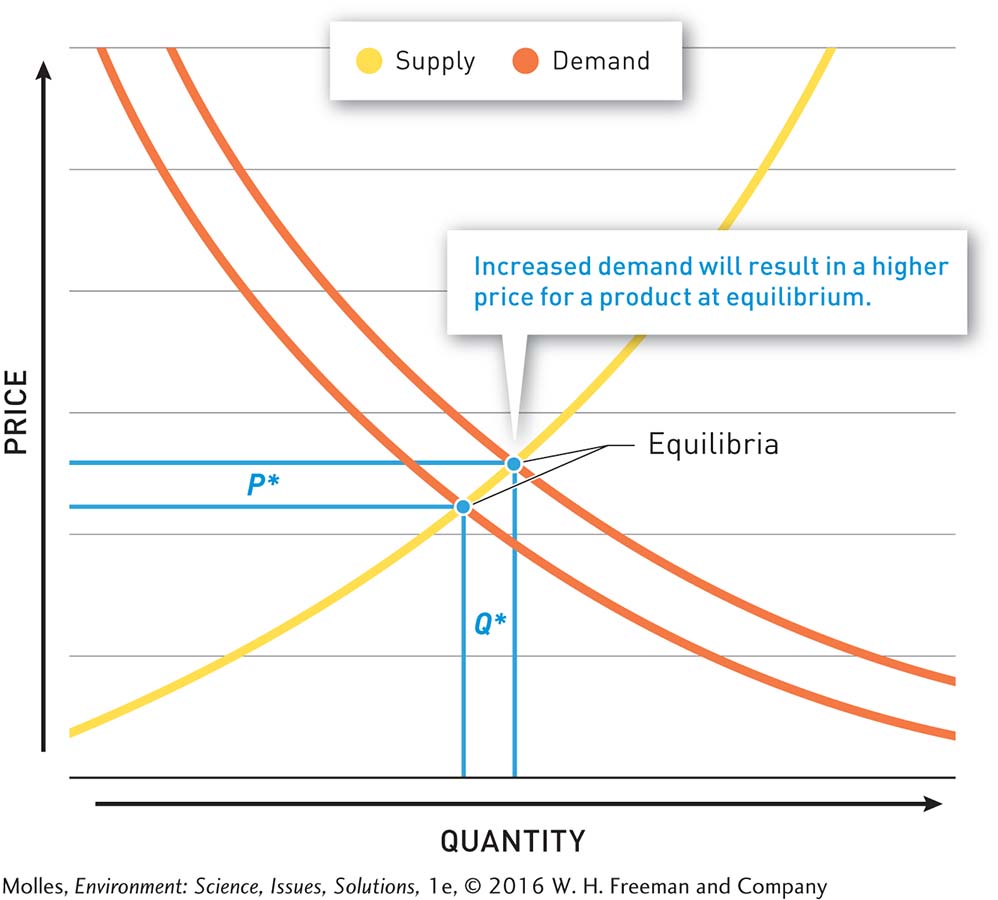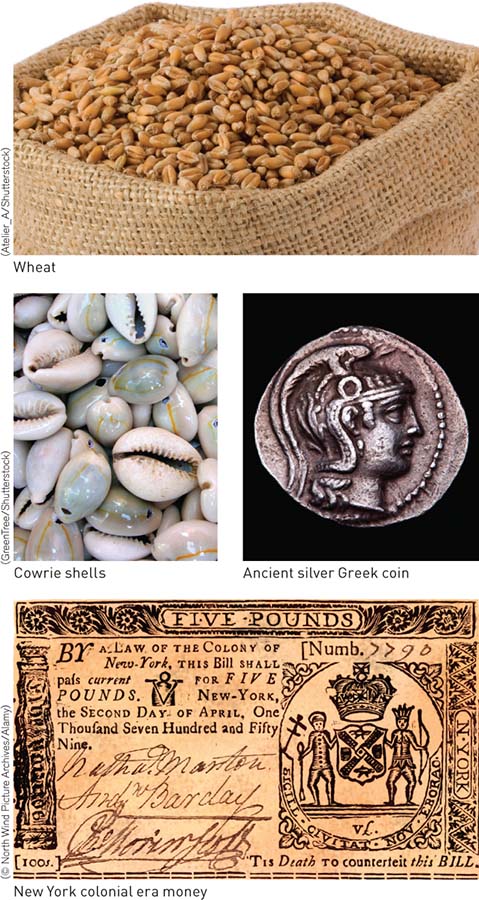2.4 Economic systems and their currencies take several forms
Humans depend on natural systems and resources to support their lives and lifestyles. From ecosystems we draw resources that feed us, keep us warm, and give us livelihood. As we have seen, as the Maasai established systems for trading goods and services, they were building an economic system. Like natural ecosystems, human economies involve the movement of matter and energy. These flows are dictated not only by physical laws, such as the laws of thermodynamics, but also by social conventions and regulations. Economics adds a new layer of complexity atop our understanding of ecosystem principles.
Economic Systems

Scientists are learning much about ecosystems around the world from people, such as the Maasai, living in traditional subsistence economies. Why might these people be a rich source of such knowledge?
subsistence economy An economy in which individuals or groups produce or harvest enough resources to largely support themselves, with fewer resources gained through purchase or trade with other groups.
The traditional economy of the Maasai is an example of a subsistence economy, in which individuals or groups produce or harvest enough resources from the natural environment to largely support themselves, with fewer resources gained through purchase or trade with other groups.
market economy An economy in which decisions about the production and consumption of goods and services are not centralized but made by businesses and individuals, generally acting in their own self-
In a modern market economy, such as that of the United States, the countries of the European Union, Canada, Japan, and other developed countries, decisions about production and consumption of goods and services are not made by some central governmental authority. Such decisions are made by businesses and individuals, generally acting in their own self-

supply and demand An economic model stating that the price of a good (or service) will reach equilibrium when the consumer demand for it at a certain price equals the quantity supplied by producers.
In a market economy, the price of goods and services is generally determined by their supply and demand (Figure 2.15). If the demand for oranges one year remains constant, but the supply increases, we end up with a surplus that causes their price to decline. The price will also drop if the demand declines but the supply stays the same. A shortage can occur if either the demand goes up or the supply goes down, leading to a spike in prices. Supply and demand affects the availability of a particular good. This is important to keep in mind, since most of the goods we consume are either natural resources or impact the environment in some way through their production or sourcing. For example, drilling for oil to meet the demand for fossil fuels directly impacts the drill site for that oil, as well as the atmosphere, when the fossil fuel is burned. For reasons like this, the economy and the environment are often portrayed as being in opposition to each other.

centrally planned economy An economy in which decisions about the production and consumption of goods and services are made by a central authority. See market economy.
black market The exchange of illegal goods and services.
In a centrally planned economy, a central authority sets prices and makes decisions about production and consumption of goods and services. Because centrally planned economies are slower to react than market economies, they are particularly susceptible to developing shortages and surpluses, and residents often resort to illegal or black markets to obtain their goods. Contemporary examples of centrally planned economies are those of Cuba and North Korea.
Property
state property Property owned by federal, state, or local governments.
Each economic system places different limits on the ownership of property, which has consequences for environmental management. The term property is used to refer to land, manufactured goods, or resources such as freshwater, minerals, or fish stocks. Under a market economy, we can generally identify four property regimes: state property, private property, communal property, and open access. Government-
private property Property owned by individuals.
common property Property owned or controlled by a community, such as an indigenous tribe.
open access A property for which there are no restrictions about who may enter and exploit its resources.
Private property, by contrast, implies that the owner has the full right to use and benefit from her property so long as she is following all applicable laws and not harming others. Common property is a form of private property, but rather than being owned by an individual, it is owned by a group. Members of the group control access to the property and exclude those who are not members. The last type of property, open access, implies that neither the government nor an individual has the right to exclude others. In other words, it’s first come, first served.
Money

Europeans were shocked when they learned, in the 13th century, that paper currency was used in China. Why might this have seemed such a radical invention?
money A medium of exchange using coins or paper bills.
While traditional Maasai could get by using livestock as a form of currency, modern economies depend on money. Money is a medium of exchange for goods and services that has evolved over thousands of years (Figure 2.16). Originally, commodities such as cattle or grain, which carry inherent value in terms of both material (nutrients) and energy (calories), were used as modes of exchange. The bartering of commodities eventually gave way to the exchange of other currencies. One of the earliest currencies, cowrie shells, which can be gathered in shallow tropical waters, was used as money in China and some regions in Africa. Over time, the minting of metal coins and use of paper money rather than shells became widespread.

For a time, the value of paper money was tied to standard quantity of gold, a practice known as the gold standard. The gold standard was abandoned in the 20th century and has been replaced by complex international regulations governing the value of money.
While we may use the flow of money to measure economic activity, that flow is symbolic of the exchange of goods and services, which is tied to the flow and transformation of matter and energy. When you buy a tablet computer for a certain number of U.S. dollars, euros, or Chinese yuan, you are exchanging your money for the material, energy, engineering, labor, and proprietary information that went into the production, transport, and marketing of the computer. You are also paying for the service provided by the seller who makes it available for your purchase. Conversely, when you earn money, you are exchanging the energy, labor, and proprietary information that went into your work.
Think About It
How is money related to the movement of energy and matter in economic systems?
Why does the law of supply and demand have more influence on the price of goods in a market economy than in a centrally planned economy?
What main factors likely influenced the evolution of money?
2.1–2.4 Science: Summary
The basic constituent of all matter, the atom, is the smallest particle of a substance that retains its properties. Substances composed of a single type of atom are called elements. Two or more atoms held together by chemical bonds form a molecule. All activity on Earth, whether in an ecosystem or as part of a modern economy, is fueled by energy. Energy, which comes in many forms of potential and kinetic energy, is defined as the capacity to do work. According to the first law of thermodynamics, one form of energy may be transformed into other forms, but the total amount of energy in a system plus its surroundings remains the same. A consequence of the second law of thermodynamics is that the overall quality of energy declines with each energy transformation, or transfer, reducing the energy available to do work. During chemical reactions, matter is neither created nor destroyed, but is conserved.
In ecosystems, matter is recycled through the biogeochemical cycles. The movement of energy and materials in an ecosystem is reflected in its food web and energy pyramid, which connect the organisms in an ecosystem through their feeding relationships. Matter and energy also flow through economic systems, which range from subsistence economies to market-